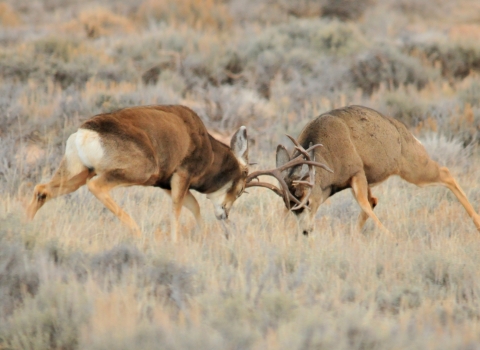Threads of green exist in the otherwise arid lands of central Washington. Riparian areas along rivers and streams act as ribbons of life, providing much needed water and habitat for wildlife. Following the fifth largest wildfire in Washington state history in 2020, the U.S. Fish & Wildlife Service and partners went to work to restore some of these important areas along Foster Creek in Douglas County using structures that emulate the work of some of the natural world’s most prolific architects.
On September 7, 2020, the Pearl Hill Fire started near Bridgeport, Washington, close to the headwaters of Foster Creek. In just 24 hours, 174,000 acres burned in the massive blaze as it roared across the grass and sagebrush sagebrush
The western United States’ sagebrush country encompasses over 175 million acres of public and private lands. The sagebrush landscape provides many benefits to our rural economies and communities, and it serves as crucial habitat for a diversity of wildlife, including the iconic greater sage-grouse and over 350 other species.
Learn more about sagebrush -laden landscape. By the time the fire merged with the separate Cold Springs Fire to the north, 413,653 acres had burned in all. Over 100 structures were destroyed and the ecological impact was significant.
The combination of invasive grasses, low humidity, and high winds resulted in a fire that burned hotter and faster than normal. An altered landscape emerged from the flames. Trees and shrubs like sagebrush were removed from the land with nothing but piles of ash left behind. An environment once covered with sage, flowering forbs, and native bunch grasses, emerged from the fire charred and barren.
For East and West Foster Creek, this meant that there were now even fewer plants to anchor soil to its streambanks during high flow periods. Without those trees and shrubs to hold it in place, heavy stream flows can cut deeper into the stream bank, forming steep-walled canyons that allow water to move faster, with more power. This torrent of water can have detrimental effects to animals that live near the stream and those that live in the stream itself, those that require shelter from the fast-moving current.
Enter, nature's furry, teeth-wielding engineers.
Beaver dams can act as natural speed bumps– slowing water velocity, increasing complexity in stream flows, creating ponds, and flooding adjacent areas. Beavers are native to the Foster Creek area. Their dams provide habitat to other plants and animals, and in fire-prone systems these wet and flooded areas can prove to be a lifeline.
In 2021, Foster Creek Conservation District, the U.S. Fish and Wildlife Service’s Partners for Fish and Wildlife Program, and the National Resource Conservation Service started assessing areas of greatest restoration need along the creek in the burn area.
Using beaver dams as inspiration, the Service and partners began placing low-cost structures in the stream– wooden posts with branches woven between them. With these structures, the stream flow can be redirected and collected, much like the impact of a beaver’s dam. Taking a cue from nature, these structures will help the plants and wildlife in the area recover more quickly.
Anabranch Solutions LLC, a contractor on the project, specializes in watershed project planning and has dedicated crews for building these structures. By the end of 2021, over 2-miles of Foster Creek underwent restoration work, and an additional 156 “beaver dam analog” structures were implemented in 2023.
The great “green-up” that has resulted from increased wetted soil, strategic plantings, and growth in actual beaver populations in the system calls for much celebration. Anabranch Solutions, Foster Creek Conservation District, the Service, Trout Unlimited, the Washington Department of Fish & Wildlife, and other partners will continue to work on restoring the area impacted by the Pearl Hill Fire so that the fire scars are a distant memory and wildlife and its habitat thrive once again. When it comes to habitat restoration, sometimes low-tech is best.





